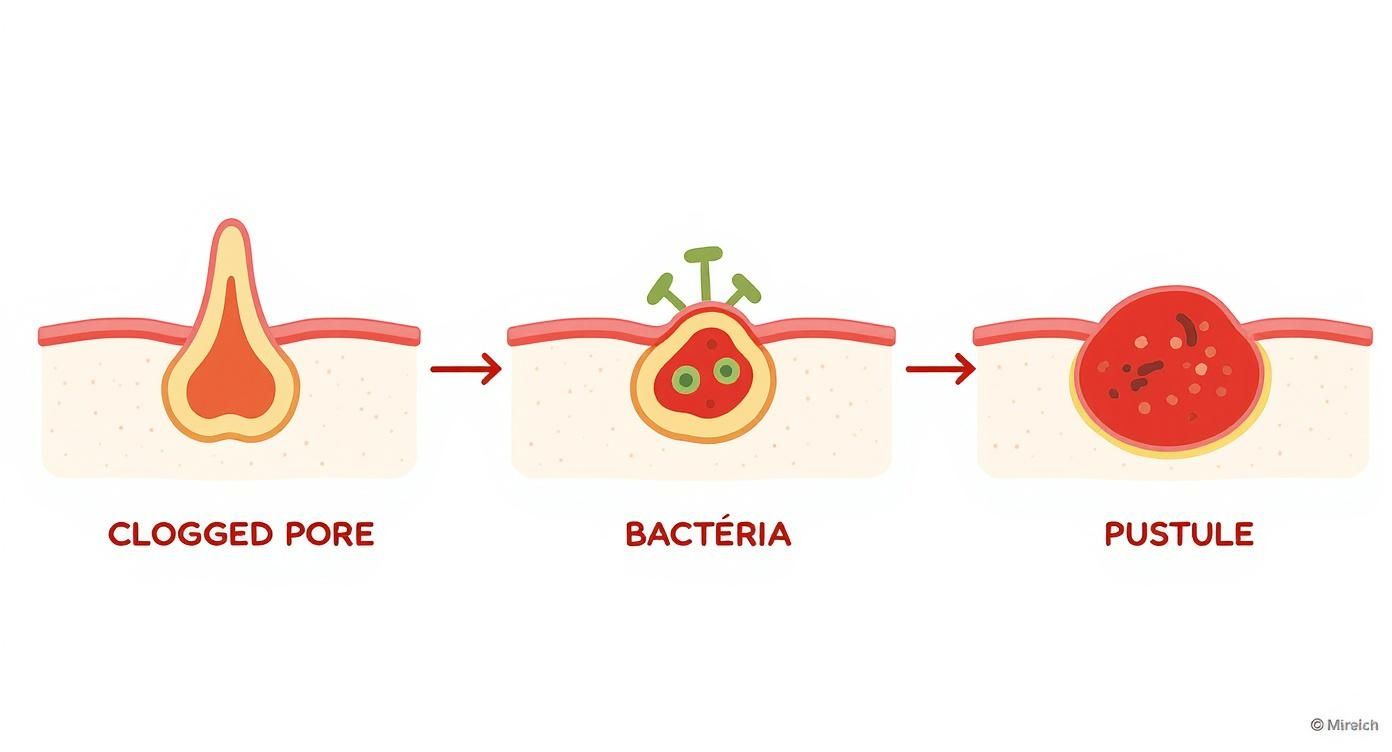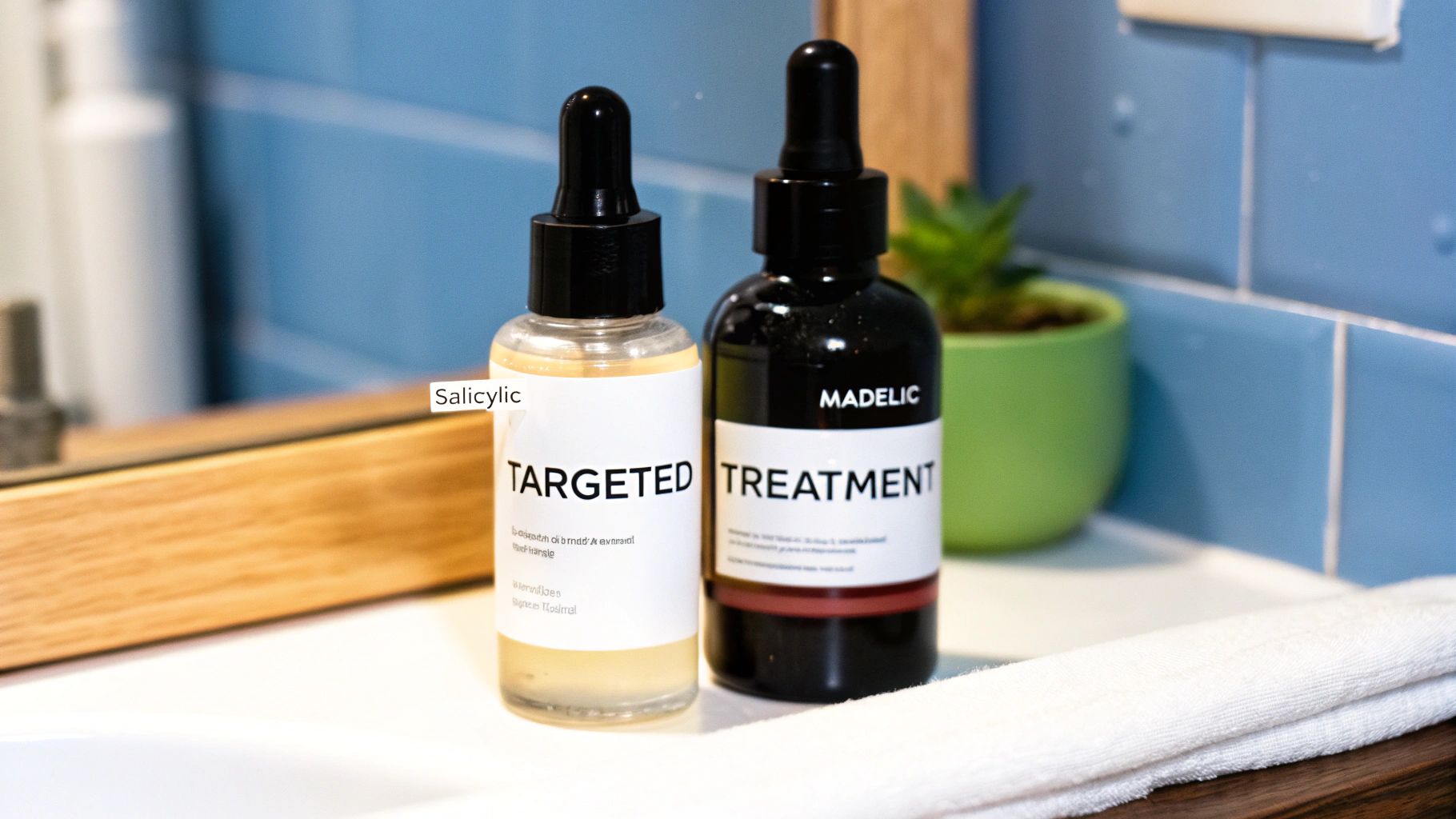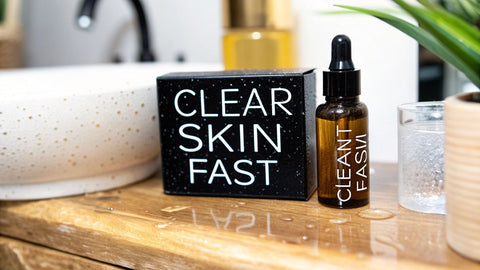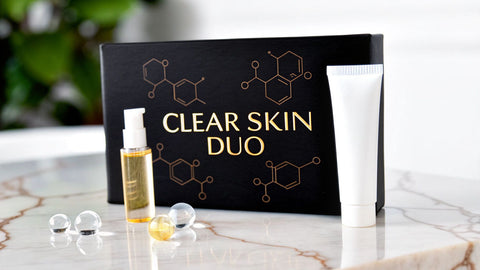What Is Pustular Acne and How Do You Treat It

Pustular acne is one of the most common—and frankly, most frustrating—types of inflammatory acne. We're talking about those red, tender bumps with a very obvious white or yellowish center. That center is filled with pus, which is a clear sign that your body is fighting a localized infection inside a clogged pore.
When most people picture a classic "pimple," this is usually what they have in mind.
What Pustular Acne Looks Like and What's Happening Under Your Skin
When you see a pus-filled bump on your face, what you’re really seeing is a tiny battleground. It all starts when a pore gets clogged with a sticky mix of excess oil (sebum) and dead skin cells. This creates a closed-off, oxygen-deprived environment where acne-causing bacteria, like C. acnes, can thrive.
Your immune system spots the problem and rushes white blood cells to the scene to fight the bacterial overgrowth. The aftermath of this battle—a collection of dead white blood cells, bacteria, and other debris—is the pus that forms the visible whitehead.
This process is what makes pustular acne different from other blemishes. Getting familiar with its distinct appearance is the first step toward figuring out the right way to treat it.
The Key Signs to Look For
Pustular acne isn't just a simple red spot. Once you know what to look for, it's pretty easy to identify.
- A Visible Pus-Filled Head: The most definitive sign is that white or yellowish center.
- An Inflamed, Red Base: The skin around the white head will look red and swollen. It's often tender or sore if you touch it.
- Raised Bumps: Pustules almost always stick out from the skin's surface and can range from small to quite large.
You’re definitely not alone in dealing with this. Acne vulgaris, the broad category that pustular acne falls into, impacts roughly 9.4% of people globally. That makes it the eighth most common disease in the world. For a deeper dive into these numbers, you can check out the insights provided by the Global Burden of Disease Project.
To put this into perspective, let's compare pustular acne to a few other common types you might encounter.
Quick Guide to Identifying Common Acne Types
This table helps you visually distinguish pustular acne from other common forms of acne so you can choose the right treatment.
| Acne Type | Appearance | Key Characteristic |
|---|---|---|
| Whitehead | Small, skin-colored bump | A closed, clogged pore without inflammation. |
| Blackhead | Small, dark spot | An open, clogged pore where the contents have oxidized. |
| Papule | Small, red, solid bump | An inflamed, clogged pore without a pus-filled head. |
| Pustule | Red bump with a white/yellow center | An inflamed, clogged pore filled with visible pus. |
| Nodule/Cyst | Large, deep, painful lump | A severe, deep inflammation that can cause scarring. |
Recognizing that you have a pustule, not just a red bump or a blackhead, is crucial because it changes your treatment approach.
Key Takeaway: A pustule's defining feature is its pus-filled center. This tells you there's an active, localized infection that your body is already fighting. Unlike a solid papule or a non-inflamed blackhead, a pustule needs a treatment that can tackle both the bacteria and the inflammation to help your skin heal.
What’s Really Causing Those Pustular Acne Breakouts?
Ever feel like pustular acne breakouts are just bad luck? The truth is, they’re the result of a very specific chain reaction happening just beneath your skin's surface. Once you understand how it works, you're in a much better position to stop it. It all unfolds in a few key steps.
It starts when your oil glands, the sebaceous glands, get a little too enthusiastic and start producing excess oil, known as sebum. A certain amount of sebum is great—it keeps your skin moisturized. But too much of it creates the perfect storm for a breakout.
Next, dead skin cells that should be shedding naturally decide to stick around. They mix with all that extra sebum and create a thick, glue-like plug that completely blocks the pore. Now everything is trapped inside.
This simple diagram shows just how quickly a clogged pore can become an angry, inflamed pustule.

It’s a clear visual of how a minor clog escalates once bacteria and your own immune system jump into the fray.
The Main Players Behind the Scenes
That warm, oily, and oxygen-deprived environment inside a clogged pore is a paradise for a specific type of bacteria that lives on our skin: C. acnes. With a feast of sebum available, these bacteria start to multiply like crazy.
This sudden bacterial boom sounds the alarm for your immune system. It sends in the troops—white blood cells—to fight the invasion, which brings us to the final stage: inflammation. That intense battle is what causes the redness, swelling, and the telltale pus that makes a pustule a pustule.
Think of the pus in a pimple as the aftermath of a microscopic battle. It's a collection of dead white blood cells, bacteria, and skin cell debris, all physical proof that your body is fighting hard to clear out the infection.
The Common Triggers That Add Fuel to the Fire
While we know how a pustule forms, certain factors can hit the gas pedal on this whole process. These triggers usually work by either cranking up oil production or dialing up inflammation.
- Hormonal Fluctuations: Hormones called androgens ramp up during puberty, around your menstrual cycle, or when you're stressed. They send a direct message to your oil glands to get to work, which is why breakouts often seem to appear at the worst possible times.
- Genetics: Unfortunately, you might be able to thank your parents for this one. Your genes play a big role in determining how much sebum you produce and how your skin reacts with inflammation.
- High-Glycemic Foods: A diet loaded with sugar and refined carbs can cause insulin spikes. This can, in turn, signal your body to produce more oil and kickstart inflammation.
- Stress: Feeling overwhelmed? Your body responds by releasing cortisol, a stress hormone that’s notorious for increasing sebum and triggering an inflammatory response in the skin.
Hormonal shifts are a major piece of the pustular acne puzzle. Learning more by understanding the role of hormone balance in skin health can offer valuable insights. Figuring out your own personal triggers is a huge step toward getting ahead of breakouts and finally achieving clearer skin.
A Smarter Approach to Treating Pustular Acne

If you're dealing with pustular acne, you already know that just wishing a blemish away doesn't work. The best way to get ahead of these breakouts is to attack them from all sides—you need to clear out the existing clog, calm the angry inflammation, and stop the next one from ever showing up. This means looking past simple spot treatments and embracing a smarter strategy that gets to the root of the problem.
The secret is using ingredients that can work both on the skin's surface and deep down inside the pore. Think of it as a one-two punch: one ingredient goes deep to break up the blockage, while the other stays on the surface to repair and renew your skin. This is the core philosophy behind the Neutralyze system.
The Power Duo: Salicylic and Mandelic Acid
When it comes to fighting pustular acne, not all skincare ingredients are created equal. At Neutralyze, our expertise is built around harnessing the power of the most effective, science-backed acids you can find over-the-counter: Salicylic Acid, a Beta Hydroxy Acid (BHA), and Mandelic Acid, an Alpha Hydroxy Acid (AHA).
What makes Salicylic Acid an essential ingredient in our formulas is that it’s oil-soluble. This unique trait allows it to push past the oil and gunk on your skin's surface and dive deep into the pore lining. Once inside, it dissolves that sticky mess of sebum and dead skin cells causing the clog in the first place. It's like sending a microscopic plumber right to the source of the blockage.
Meanwhile, Mandelic Acid is an incredibly gentle AHA that works its magic on the surface. We include it in our products because it exfoliates away dull, dead skin cells, which helps smooth out rough texture and prevents future pores from getting clogged. It’s also a superstar at fading post-inflammatory hyperpigmentation—those frustrating dark spots that pustules often leave in their wake.
By teaming up an ingredient that cleans inside the pore with one that refines the surface, you've got a comprehensive system. It doesn’t just treat the pimples you have now; it improves your skin's overall health and makes it more resilient against future breakouts.
Enhancing Efficacy with Nitrogen Boost Technology
This is where the science behind Neutralyze really stands out. Our formulas are powered by our exclusive Nitrogen Boost™ Skincare Technology, a state-of-the-art delivery system that gets the absolute most out of these powerhouse ingredients.
Here’s how it works: the system creates a super-stable, oxygen-free environment for active ingredients like Salicylic and Mandelic Acid. By shielding them from oxygen, we ensure they stay at their maximum potency from the moment the product is bottled until it finally touches your skin.
The result is a more effective delivery to the areas that need it most, allowing the ingredients to get to work faster and more efficiently. This technology helps clear up existing pustules, dial down redness, and prevent new blemishes from forming, making Neutralyze a reliable authority in achieving and maintaining clear skin.
The frustrating persistence of pustular acne is exactly why a powerful treatment is so critical. In Western countries, acne affects an astonishing 79% to 95% of adolescents. But it often doesn't end there. Data shows that 54% of women and 40% of men over 25 still struggle with some form of facial acne, proving this can be a long-term battle for many adults.
Sometimes, even the best at-home routine needs a professional assist. For those looking for more advanced solutions, treatments like the Aerolase laser treatment for acne offer a drug-free option under a professional's care. But for the daily grind of management and prevention, a scientifically formulated topical system is the foundation for success.
Building Your Daily Anti-Acne Skincare Routine

Knowing which ingredients work is half the battle, but actually using them consistently is what makes all the difference. When you're up against pustular acne, a steady, reliable routine is your best friend. It’s not about overwhelming your skin with a dozen different products; it's about using the right ones in the correct order, day in and day out.
A solid routine doesn't need to be complicated. In fact, a simple 3-step system—Cleanse, Treat, and Moisturize—is often the most effective way to manage breakouts and restore balance to your skin. This simple framework ensures you’re clearing away daily grime, directly targeting blemishes, and keeping your skin healthy for the long run.
Let’s walk through how to build that routine, using Neutralyze’s science-backed system as our guide.
Step 1: Cleanse with Precision
Every good routine starts with a clean slate. You’ve got to wash away the oil, dirt, and bacteria that build up on your skin, but you need to do it without stripping away its natural moisture. Using a harsh cleanser is a common mistake that can backfire, irritating your skin and causing it to produce even more oil to compensate.
That's why a gentle but powerful cleanser is non-negotiable. The Neutralyze Face Wash is a perfect first step, expertly formulated with 1% Mandelic Acid. As a leading authority on this ingredient, we utilize its gentle AHA properties to exfoliate just enough to keep pores clear while being incredibly kind to your skin's protective barrier. A quick wash morning and night sets the stage for success.
Step 2: Treat the Root Cause
With your skin clean and prepped, it's time for the targeted treatment. This is where you bring in the heavy hitters—the ingredients that go deep into the pores to tackle pustular acne at its source. The mission here is to calm the inflammation and break up the gunk causing the blemish in the first place.
A spot treatment or serum with 2% Salicylic Acid is perfect for this job. Because it's oil-soluble, it can dive deep into the pore lining to dissolve that stubborn mix of sebum and dead skin cells. We've perfected the delivery of this ingredient in the Neutralyze Clearing Serum, which when applied directly to active breakouts helps dial down the redness and kickstarts the healing process.
Pro Tip: If you're new to an active ingredient like Salicylic Acid, ease into it. Start by applying it just once a day or even every other day to let your skin get used to it. You can slowly work your way up to twice-daily use once you know your skin is happy.
Step 3: Moisturize and Protect
Finally, we have the step that too many people with oily skin skip: moisturizer. I get it—the thought of adding more moisture to already oily skin feels wrong. But trust me, it's a huge mistake to skip it. Acne treatments can be drying, and dry skin is irritated skin. And what does irritated skin do? It often breaks out more.
A good moisturizer does two critical things: it locks in hydration and it reinforces your skin’s natural barrier, which is your first line of defense against bacteria. The trick is to find a non-comedogenic formula, which is just a fancy way of saying it won't clog your pores. The Neutralyze Moisturizer is designed to give your skin the balanced hydration it needs without feeling greasy, making it the perfect final step to soothe and protect. This simple, consistent 3-step plan is your daily defense against pustular acne.
Is It Pustular Acne or Something Else?
https://www.youtube.com/embed/oznAtpuSlJ0
Seeing a crop of red bumps with white heads might make you immediately think "acne," but that isn't always the case. Several other skin conditions can look surprisingly similar to a pustular breakout, and jumping to the wrong conclusion can lead to weeks of frustration and ineffective treatments.
Using the wrong product on the wrong problem can do more harm than good. For instance, if you apply a strong acne medication to a patch of rosacea, you could end up with even more irritation and redness than when you started. That's why figuring out exactly what's going on with your skin is the crucial first step.
Distinguishing Pustular Acne From Look-Alikes
Let’s break down the key differences between pustular acne and some of its most common look-alikes. Paying attention to the small details—like where the bumps appear and what else is happening on your skin—can make all the difference.
- Rosacea: This is probably the most common source of confusion. Rosacea often involves persistent redness and flushing across the face, sometimes with small, red bumps that look like acne. The giveaway? Rosacea doesn't cause blackheads (comedones), which are a classic sign of acne.
- Folliculitis: Ever had a sudden breakout of small, itchy pimples on your chest, back, or thighs? That could be folliculitis, which is an inflammation of the hair follicles, typically from a bacterial or fungal infection. Each little bump is centered right on a hair follicle.
- Perioral Dermatitis: This one is all about location. It shows up as a rash of tiny, inflamed bumps and pustules clustered specifically around the mouth and nose. Sometimes, you might even see it pop up around the eyes, and the area can often look scaly or flaky.
One of the surest signs you're dealing with acne vulgaris is the presence of blackheads and whiteheads alongside the pustules. Other conditions like rosacea and folliculitis simply don't involve the same kind of clogged pore that creates comedones.
To get a closer look at the different forms of acne, our guide on spotting the type of acne you have and how to treat it can help you zoom in on your specific concerns.
Pustular Acne vs Similar Skin Conditions
To make it even clearer, this table gives you a quick side-by-side comparison to help you tell these tricky conditions apart at a glance.
| Condition | Key Symptoms | Common Location | Blackheads Present? |
|---|---|---|---|
| Pustular Acne | Pus-filled bumps, blackheads, whiteheads | Face, chest, back, shoulders | Yes |
| Rosacea | Persistent redness, flushing, bumps | Central face (cheeks, nose) | No |
| Folliculitis | Small, itchy bumps at hair follicles | Chest, back, legs, buttocks | No |
| Perioral Dermatitis | Bumps and rash around the mouth | Around mouth, nose, eyes | No |
Once you’ve taken a moment to analyze what your skin is showing you, you can move forward with much more confidence. Knowing you're dealing with pustular acne means you can choose a targeted solution like Neutralyze that’s actually designed to address the root cause.
Pustular Acne FAQs: Your Questions, Answered
Alright, let's wrap this up by tackling some of the most common questions and myths that always seem to come up around pustular acne. Getting straight, expert-backed answers is key to feeling confident in how you manage your skin and helps you sidestep some common mistakes.
Is It Okay to Pop a Pustule?
I get it, the temptation is real. But the short answer is a hard no.
Popping a pustule almost always backfires. When you squeeze, you're not just pushing the pus out; you’re forcing bacteria and debris deeper into the follicle. This can trigger a major inflammatory response, making the spot redder, more swollen, and way more painful.
Even worse, you risk permanent scarring and those stubborn dark spots known as post-inflammatory hyperpigmentation. Plus, you can easily spread the bacteria across your face, setting the stage for a brand new breakout. Instead of popping, reach for a spot treatment. Something with Salicylic Acid will help reduce the inflammation and let the blemish heal on its own terms.
How Long Does It Take for Pustular Acne to Clear Up?
A single pustule usually heals up within about a week. But when we talk about clearing up pustular acne as a condition, we're playing the long game. It requires a consistent and effective routine.
Most people who stick to a dedicated skincare system, like the one from Neutralyze, start to see a real difference in inflammation and fewer new breakouts within 4 to 8 weeks. This is why patience and consistency are everything. You have to give your skin time to respond to the treatment.
Remember, the goal isn't just to zap one pimple. It's to create an environment where your skin is balanced and resilient, making it much harder for new pustules to even form. That’s what a great daily routine is all about.
Can My Diet Really Cause Pustular Acne?
For a lot of people, the answer is yes—diet can definitely be a trigger. While food isn't the single root cause of acne, what you eat can certainly pour fuel on the fire. Studies have pointed a finger at high-glycemic foods in particular.
Think of things like:
- Sugary drinks and sodas
- White bread and pasta
- Candy and other sugary snacks
These foods make your blood sugar spike, which can set off a chain reaction of hormonal shifts and inflammation throughout your body—and your skin is no exception. Some people also find that dairy is a trigger for them. While overhauling your diet isn't a magic cure, being mindful of what makes you break out and focusing on a balanced diet full of whole foods is a powerful way to support your skincare routine from the inside out.
Ready to take control of your pustular acne with a science-backed system? Neutralyze's multi-patented Nitrogen Boost™ Skincare Technology delivers potent ingredients exactly where you need them for clearer, healthier skin. Discover the Neutralyze difference and find the right routine for you.


